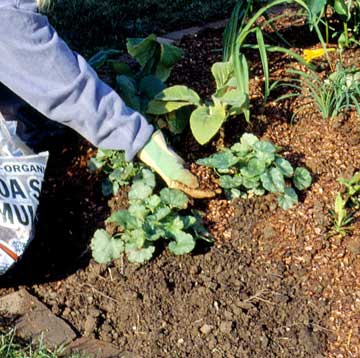





1. Pinching. Whether you grow herbs outdoors or indoors, keep the plants lush and bushy by regularly pinching 2 to 3 inches off the tips. If you desire more leaves, pinch off any flowers that form. When transplanting, remove the top two leaves from each plant to encourage root growth.
Get inspired to grow even more herbs with this list of an herb-lover's favorites.
continue reading below Use soil enhancements, fertilizers,
and mulch to improve herb growth.
Use soil enhancements, fertilizers,
and mulch to improve herb growth.
2. Fertilizing and mulching. Herbs grow best in well-drained soil. Unless you already have the alkaline or sandy soil that herbs tolerate, throw a handful each of sand, powdered lime, and powdered gypsum into every planting hole. If you have clay soil or extremely sandy ground, add compost and chopped leaves each season. At planting time and each spring, build the soil by scratching in 3 inches of compost and rotted manure. If plants appear weak, pale, or otherwise unhealthy, give them a drink of diluted fish fertilizer. Feed potted herbs every two to three weeks. Too much fertilizer (particularly nitrogen) results in lots of green leaves without much fragrance or flavor. Lay a 2-inch layer of mulch, such as cocoa bean hulls or wood chips, on bare ground between plants to suppress weeds and help preserve soil moisture. Replace mulch as it decomposes. If you live in a cold climate, use chopped leaf mulch to help protect plants over winter. After the ground freezes, lay a 4-inch layer of leaves around plants. Lay evergreen boughs over gray-leaf herbs, which need extra protection from the cold.
3. Spring pruning. Prune and clean up dead stems of last year's growth on plants, such as lemon balm, mint, artemisia, and tansy, that weren't cut back in autumn. Some perennial herbs become woody or lanky after several years in the garden. In spring, prune them back by one-third before new growth begins, in order to encourage bushy, more compact overall forms, as well as more foliage and flowers.
4. Fall cleanup. After the first frost in fall, pull up spent annual plants, such as calendula, dill, cilantro, and chervil. Shake the soil off their roots, leaving it in the garden, and toss the plant remains on the compost pile. Many gardeners prefer to leave the remains of perennial plants in the garden over winter. The stems catch leaves and snow that provide a natural blanket for the plant during the cold months. After the weather warms in spring and perennial herbs start to show new growth, trim off any dead parts and compost them.
Copyright © www.100flowers.win Botanic Garden All Rights Reserved